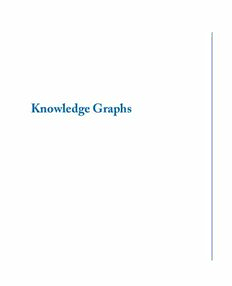Table Of ContentKnowledge Graphs
Synthesis Lectures on Data,
Semantics, and Knowledge
Editor
YingDing,UniversityofTexasatAustin
PaulGroth,UniversityofAmsterdam
FoundingEditorEmeritus
JamesHendler,RensselaerPolytechnicInstitute
SynthesisLecturesonData,Semantics,andKnowledgeiseditedbyYingDingoftheUniversityof
TexasatAustinandPaulGrothoftheUniversityofAmsterdam.Theseriesfocusesonthepivotal
rolethatdataonthewebandtheemergenttechnologiesthatsurrounditplaybothintheevolution
oftheWorldWideWebaswellasapplicationsindomainsrequiringdataintegrationandsemantic
analysis.Thelarge-scaleavailabilityofbothstructuredandunstructureddataontheWebhas
enabledradicallynewtechnologiestodevelop.Ithasimpacteddevelopmentsinavarietyofareas
includingmachinelearning,deeplearning,semanticsearch,andnaturallanguageprocessing.
Knowledgeandsemanticsareacriticalfoundationforthesharing,utilization,andorganizationof
thisdata.Theseriesaimsbothtoprovidepathwaysintothefieldofresearchandanunderstanding
oftheprinciplesunderlyingthesetechnologiesforanaudienceofscientists,engineers,and
practitioners.
Topicstobeincluded:
• Knowledgegraphs,bothpublicandprivate
• LinkedData
• Knowledgegraphandautomatedknowledgebaseconstruction
• Knowledgeengineeringforlarge-scaledata
• Machinereading
• UsesofSemanticWebtechnologies
• Informationandknowledgeintegration,datafusion
• Variousformsofsemanticsontheweb(e.g.,ontologies,languagemodels,anddistributional
semantics)
• Terminology,Thesaurus,&OntologyManagement
• Querylanguages
iv
KnowledgeGraphs
AidanHogan,EvaBlomqvist,MichaelCochez,Claudiad’Amato,GerarddeMelo,Claudio
Gutierrez,SabrinaKirrane,JoséEmilioLabraGayo,RobertoNavigli,SebastianNeumaier,
Axel-CyrilleNgongaNgomo,AxelPolleres,SabbirM.Rashid,AnisaRula,LukasSchmelzeisen,
JuanSequeda,SteffenStaab,andAntoineZimmermann
2021
WebDataAPIsforKnowledgeGraphs:EasingAccesstoSemanticDataforApplication
Developers
AlbertoMeroño-Peñuela,PasqualeLisena,andCarlosMartínez-Ortiz
2021
DesigningandBuildingEnterpriseKnowledgeGraphs
JuanSequedaandOraLassila
2021
LinkedDataVisualization:Techniques,Tools,andBigData
LauraPo,NikosBikakis,FedericoDesimoni,andGeorgePapastefanatos
2020
OntologyEngineering
ElisaF.KendallandDeborahL.McGuinness
2019
DemystifyingOWLfortheEnterprise
MichaelUschold
2018
ValidatingRDFData
JoséEmilioLabraGayo,EricPrud’hommeaux,IovkaBoneva,andDimitrisKontokostas
2017
NaturalLanguageProcessingfortheSemanticWeb
DianaMaynard,KalinaBontcheva,andIsabelleAugenstein
2016
TheEpistemologyofIntelligentSemanticWebSystems
Mathieud’AquinandEnricoMotta
2016
EntityResolutionintheWebofData
VassilisChristophides,VasilisEfthymiou,andKostasStefanidis
2015
v
LibraryLinkedDataintheCloud:OCLC’sExperimentswithNewModelsofResource
Description
CarolJeanGodby,ShenghuiWang,andJeffreyK.Mixter
2015
SemanticMiningofSocialNetworks
JieTangandJuanziLi
2015
SocialSemanticWebMining
TopeOmitola,SebastiánA.Ríos,andJohnG.Breslin
2015
SemanticBreakthroughinDrugDiscovery
BinChen,HuijunWang,YingDing,andDavidWild
2014
SemanticsinMobileSensing
ZhixianYanandDipanjanChakraborty
2014
Provenance:AnIntroductiontoPROV
LucMoreauandPaulGroth
2013
Resource-OrientedArchitecturePatternsforWebsofData
BrianSletten
2013
AaronSwartz’sAProgrammableWeb:AnUnfinishedWork
AaronSwartz
2013
Incentive-CentricSemanticWebApplicationEngineering
ElenaSimperl,RobertaCuel,andMartinStein
2013
PublishingandUsingCulturalHeritageLinkedDataontheSemanticWeb
EeroHyvönen
2012
VIVO:ASemanticApproachtoScholarlyNetworkingandDiscovery
KatyBörner,MichaelConlon,JonCorson-Rikert,andYingDing
2012
LinkedData:EvolvingtheWebintoaGlobalDataSpace
TomHeathandChristianBizer
2011
Copyright©2022byMorgan&Claypool
Allrightsreserved.Nopartofthispublicationmaybereproduced,storedinaretrievalsystem,ortransmittedin
anyformorbyanymeans—electronic,mechanical,photocopy,recording,oranyotherexceptforbriefquotations
inprintedreviews,withoutthepriorpermissionofthepublisher.
KnowledgeGraphs
AidanHogan,EvaBlomqvist,MichaelCochez,Claudiad’Amato,GerarddeMelo,ClaudioGutierrez,
SabrinaKirrane,JoséEmilioLabraGayo,RobertoNavigli,SebastianNeumaier,
Axel-CyrilleNgongaNgomo,AxelPolleres,SabbirM.Rashid,AnisaRula,LukasSchmelzeisen,
JuanSequeda,SteffenStaab,andAntoineZimmermann
www.morganclaypool.com
ISBN:9781636392356 paperback
ISBN:9781636392363 PDF
ISBN:9781636392370 hardcover
DOI10.2200/S01125ED1V01Y202109DSK022
APublicationintheMorgan&ClaypoolPublishersseries
SYNTHESISLECTURESONDATA,SEMANTICS,ANDKNOWLEDGE
Lecture#22
SeriesEditors:YingDing,UniversityofTexasatAustin
PaulGroth,UniversityofAmsterdam
FoundingEditorEmeritus:JamesHendler,RensselaerPolytechnicInstitute
SeriesISSN
Print2691-2023 Electronic2691-2031
Knowledge Graphs
Aidan Hogan Eva Blomqvist
DCC,UniversidaddeChile;IMFD LinköpingUniversity
Michael Cochez Claudia d’Amato
VrijeUniversiteitAmsterdamandDiscoveryLab, UniversityofBari
Elsevier
Gerard de Melo Claudio Gutierrez
HPI,UniversityofPotsdamandRutgersUniversity DCC,UniversidaddeChile;IMFD
Sabrina Kirrane José Emilio Labra Gayo
WUVienna UniversidaddeOviedo
Roberto Navigli Sebastian Neumaier
SapienzaUniversityofRome St.PöltenUniversityofAppliedSciences
Axel-Cyrille Ngonga Ngomo Axel Polleres
DICE,UniversitätPaderborn WUVienna
Sabbir M. Rashid Anisa Rula
TetherlessWorldConstellation,Rensselaer UniversityofBrescia
PolytechnicInstitute
Lukas Schmelzeisen Juan Sequeda
UniversitätStuttgart data.world
Steffen Staab Antoine Zimmermann
UniversitätStuttgartandUniversityofSouthampton ÉcoledesminesdeSaint-Étienne
SYNTHESISLECTURESONDATA,SEMANTICS,ANDKNOWLEDGE#22
M
&C Morgan &cLaypool publishers
ABSTRACT
This book provides a comprehensive and accessible introduction to knowledge graphs, which
haverecentlygarnerednotableattentionfrombothindustryandacademia.Knowledgegraphs
arefoundedontheprincipleofapplyingagraph-basedabstractiontodata,andarenowbroadly
deployedinscenariosthatrequireintegratingandextractingvaluefrommultiple,diversesources
ofdataatlargescale.
The book defines knowledge graphs and provides a high-level overview of how they are
used.Itpresentsandcontrastspopulargraphmodelsthatarecommonlyusedtorepresentdataas
graphs,andthelanguagesbywhichtheycanbequeriedbeforedescribinghowtheresultingdata
graph can be enhanced with notions of schema, identity, and context. The book discusses how
ontologies and rules can be used to encode knowledge as well as how inductive techniques—
based on statistics, graph analytics, machine learning, etc.—can be used to encode and extract
knowledge. It covers techniques for the creation, enrichment, assessment, and refinement of
knowledgegraphsandsurveysrecentopenandenterpriseknowledgegraphsandtheindustries
orapplicationswithinwhichtheyhavebeenmostwidelyadopted.Thebookclosesbydiscussing
thecurrentlimitationsandfuturedirectionsalongwhichknowledgegraphsarelikelytoevolve.
This book is aimed at students, researchers, and practitioners who wish to learn more
aboutknowledgegraphsandhowtheyfacilitateextractingvaluefromdiversedataatlargescale.
Tomakethebookaccessiblefornewcomers,runningexamplesandgraphicalnotationareused
throughout.Formaldefinitionsandextensivereferencesarealsoprovidedforthosewhooptto
delvemoredeeplyintospecifictopics.
KEYWORDS
knowledge graphs, graph databases, knowledge graph embeddings, graph neu-
ral networks, ontologies, knowledge graph refinement, knowledge graph quality,
knowledgebases,artificialintelligence,semanticweb,machinelearning
ix
Contents
Preface ........................................................... xv
Acknowledgments ................................................ xix
1 Introduction .......................................................1
2 DataGraphs .......................................................5
2.1 Models ......................................................... 5
2.1.1 DirectedEdge-LabeledGraphs ............................... 6
2.1.2 HeterogeneousGraphs ...................................... 8
2.1.3 PropertyGraphs ........................................... 9
2.1.4 GraphDataset............................................ 11
2.1.5 OtherGraphDataModels.................................. 12
2.1.6 GraphStores ............................................. 13
2.2 Querying....................................................... 13
2.2.1 BasicGraphPatterns ...................................... 13
2.2.2 ComplexGraphPatterns ................................... 16
2.2.3 NavigationalGraphPatterns ................................ 19
2.2.4 OtherFeatures ........................................... 22
2.2.5 QueryInterfaces .......................................... 22
3 Schema,Identity,andContext .......................................25
3.1 Schema ........................................................ 25
3.1.1 SemanticSchema ......................................... 25
3.1.2 ValidatingSchema ........................................ 27
3.1.3 EmergentSchema......................................... 32
3.2 Identity ........................................................ 35
3.2.1 PersistentIdentifiers ....................................... 35
3.2.2 ExternalIdentityLinks..................................... 37
3.2.3 Datatypes................................................ 38
3.2.4 Lexicalization ............................................ 38
3.2.5 ExistentialNodes ......................................... 39
x
3.3 Context........................................................ 40
3.3.1 DirectRepresentation...................................... 40
3.3.2 Reification ............................................... 41
3.3.3 Higher-ArityRepresentation ................................ 41
3.3.4 Annotations.............................................. 42
3.3.5 OtherContextualFrameworks............................... 44
4 DeductiveKnowledge ..............................................47
4.1 Ontologies ..................................................... 48
4.1.1 InterpretationsandModels ................................. 49
4.1.2 OntologyFeatures......................................... 51
4.1.3 Entailment .............................................. 56
4.1.4 If-Thenvs.If-and-Only-IfSemantics ......................... 56
4.2 Reasoning ...................................................... 57
4.2.1 Rules ................................................... 57
4.2.2 DescriptionLogics ........................................ 60
5 InductiveKnowledge ...............................................67
5.1 GraphAnalytics ................................................. 67
5.1.1 Techniques .............................................. 69
5.1.2 Frameworks.............................................. 70
5.1.3 AnalyticsonDataGraphs .................................. 74
5.1.4 AnalyticswithQueries ..................................... 75
5.1.5 AnalyticswithEntailment .................................. 76
5.2 KnowledgeGraphEmbeddings..................................... 76
5.2.1 Tensor-BasedModels ...................................... 78
5.2.2 LanguageModels ......................................... 88
5.2.3 Entailment-AwareModels.................................. 90
5.3 GraphNeuralNetworks........................................... 91
5.3.1 RecursiveGraphNeuralNetworks............................ 91
5.3.2 Non-RecursiveGraphNeuralNetworks ....................... 95
5.4 SymbolicLearning............................................... 96
5.4.1 RuleMining ............................................. 97
5.4.2 AxiomMining .......................................... 100
5.4.3 HypothesisMining....................................... 102

